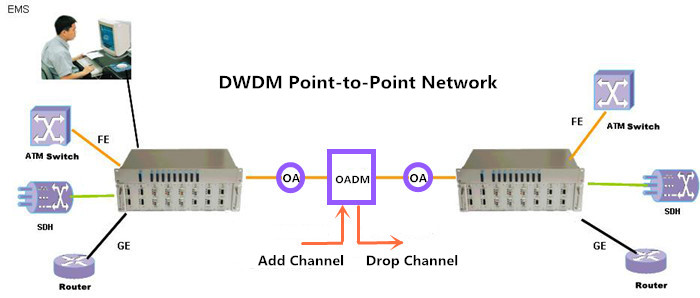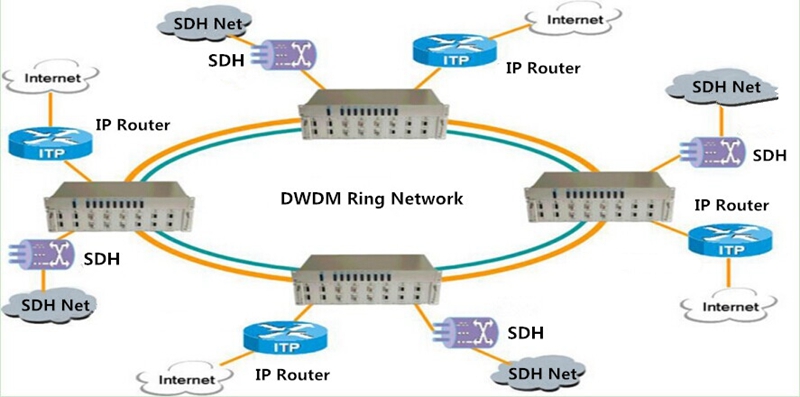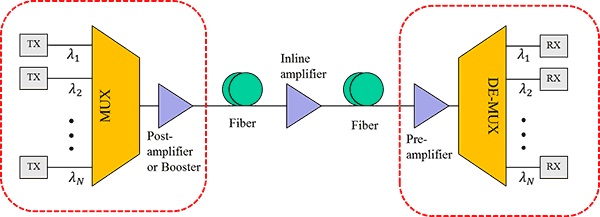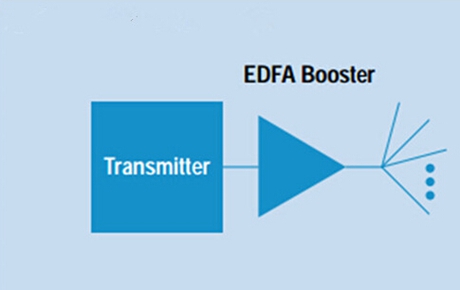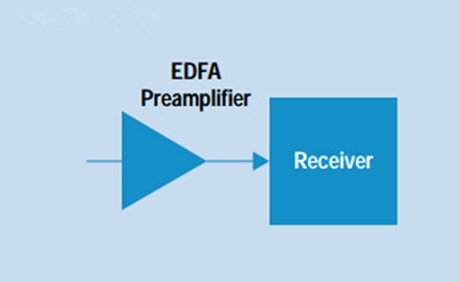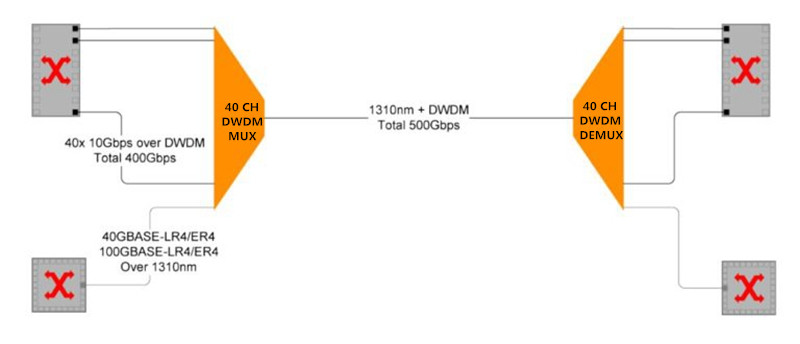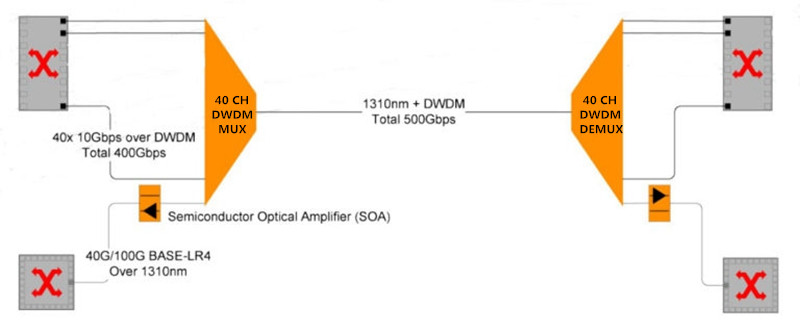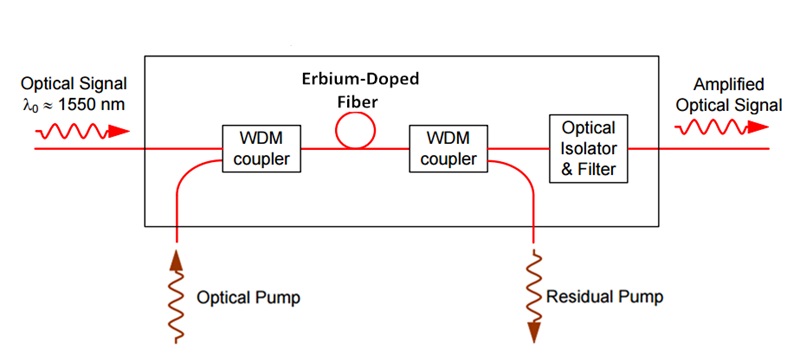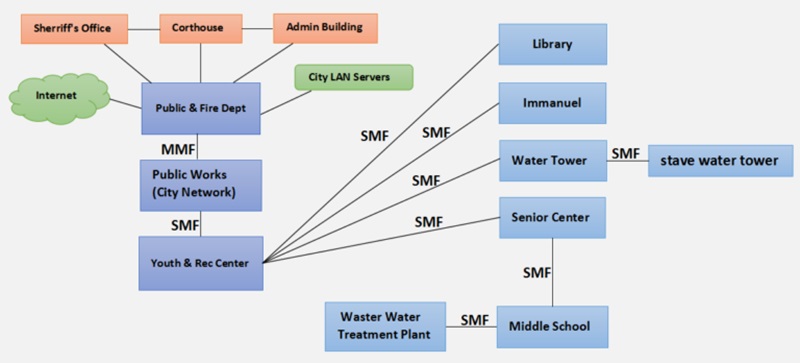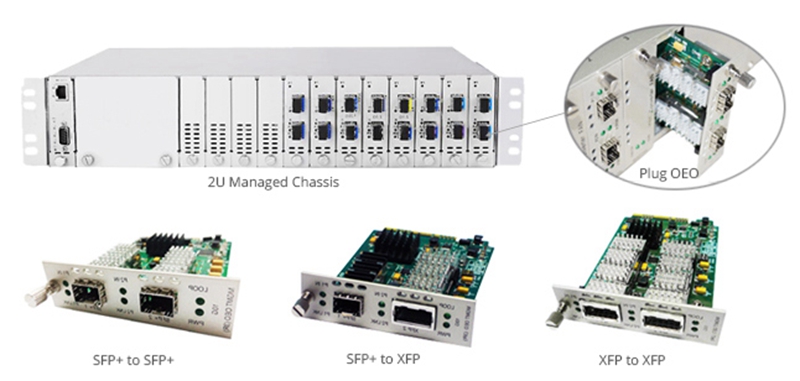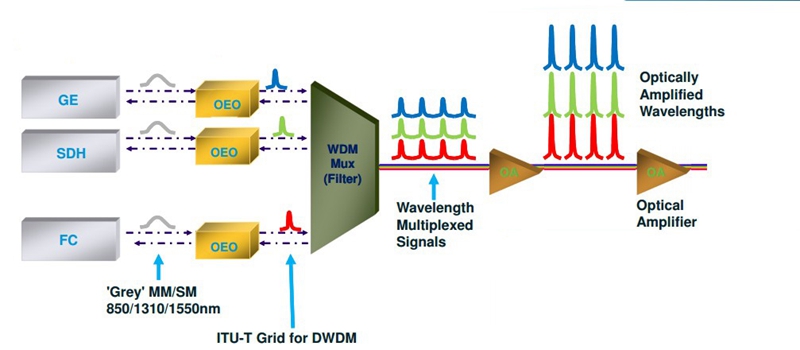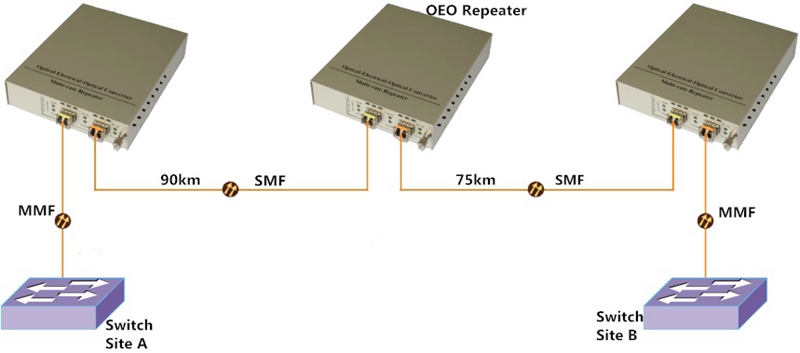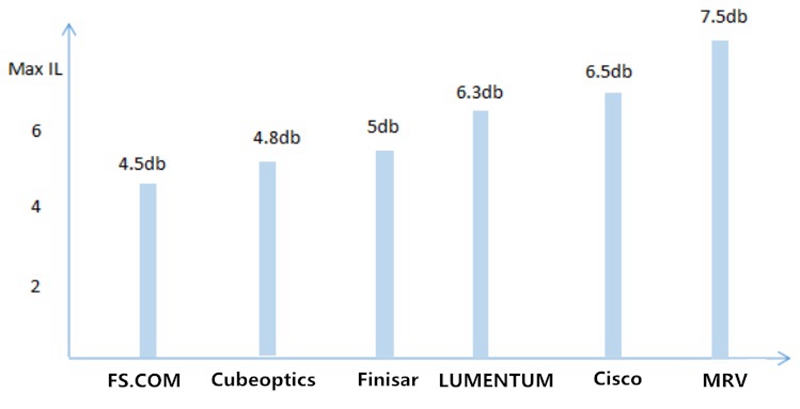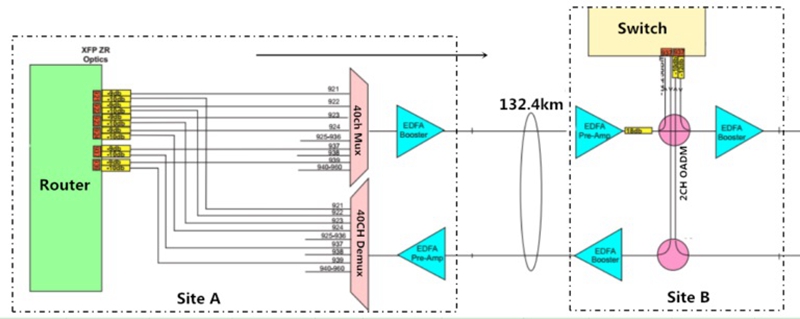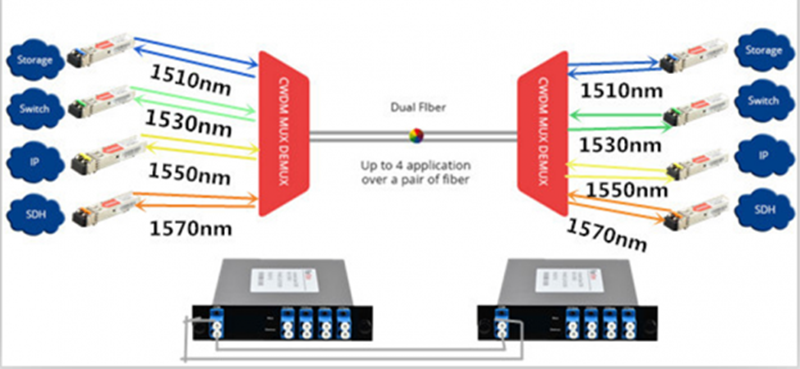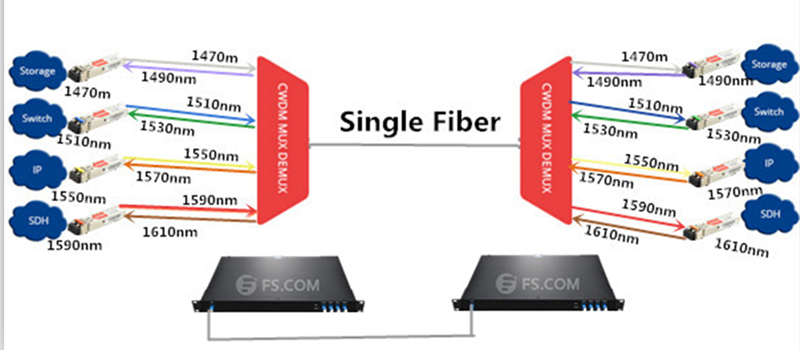Why Not Using DWDM Technology to Build Your Network?
četvrtak , 08.06.2017.Currently, more and more users choose to deploy DWDM networks on the basis of their existing networks, as the normal network can’t afford enough capacity for their daily use. Considering that there may be some confusion for designing the DWDM networks, this paper will mainly introduce the basic knowledge of DWDM technology and analyze the difference between SDH and DWDM technology. To better understand the DWDM technology, this paper will also guide users to deploy two common kinds of DWDM network. Hope the DWDM information in the paper would be useful for deploying a smooth DWDM network with higher transmission rate and capacity.
Introduction to DWDM Technology
DWDM technology is an ideal solution to address the capacity-hungry issue, which can multiplex several wavelengths for transmission different kinds of signals through one single fiber. In principle, the network utilizing DWDM technology enables carry up to 140 channels for transmitting signals, finally achieving high bandwidth transmission. As for the DWDM components, it basically includes DWDM multi-channel Mux/Demux, dispersion compensation module, fiber optic amplifier, optical transponder, and so on.
SDH vs DWDM Technology
As we know, SDH is the technology combining more than one lower-speed electrical or optical signals into a single higher bit rate signal with a single wavelength for transmission over a single fiber or wire. In the network utilizing SDH technology, Time division multiplexing (TDM) or statistical TDM is used, which means the signals in SDH network will be received by distributed across time slots. As for the DWDM technology, it uses wavelength multiplexing method, so that the signals can arrive at the receiver simultaneously. In the DWDM network, the DWDM multi-channel Mux/Demux mentioned above is the key components that can give different wavelengths to the different optical signals and multiplex them, so that the integrate signal with different wavelengths can be transmitted over a single fiber.
In short, SDH uses time division multiplexing, while DWDM works with wavelength division multiplexing. Compared to the SDH technology, DWDM can give different wavelengths to the optical signals, which allows the signals to be transmitted with their own speed and protocol and arrive at the same time. Besides, the SDH network can transmit both electrical or optical signals, while DWDM network only supports optical signal transmission.
Common DWDM Network Designs
Generally speaking, there are many kinds of DWDM networks with topological configurations, each of them has different requirements and can be used for different applications. They are basically DWDM point-to-point network, fully connected mesh network, star network, ring network and hybrid DWDM network consisting of stars and/or rings that are interconnected with point-to-point links. The following will mainly introduce the two most common DWDM networks, point-to-point network and ring network for your reference.
DWDM Point-to-Point Network: this kind of DWDM network is always deployed for long distance transmission with fast transmission speed, high bandwidth, great reliability and path restoration capability. The numbers of fiber optic amplifier used in this DWDM network is often less than 10, while the transmission distance can be up to several hundred kilometers. If optical add-drop multiplexer (OADM) is used, channels can be dropped or added along the path of the DWDM link. To better know the DWDM point-to-point network, here offers a figure that shows a DWDM point-to-point network design with the use of DWDM multi-channel Mux/Demux, OADM and fiber optic amplifier.
DWDM Ring Network: In general, this kind of DWDM network is often applied in local or metropolitan areas that can support the DWDM network at lengths up to dozens of kilometers. A basic DWDM ring network is shown in the following figure that has many nodes fully interconnected by the fiber, and sometime there are two fiber rings in a DWDM ring network which are deployed for protecting the network. Besides, the DWDM components like DWDM multi-channel Mux/Demux, OADM and optical amplifier are also required in the DWDM ring network.
Conclusion
DWDM technology is an economical solution for transmitting multiple signals through one fiber, which can solve the problem of insufficient capacity in your network. In contrast with SDH technology, DWDM technology enables the optical signals to be transmitted fast and arrive at the receivers simultaneous, while offering much higher capacity and transmission rate. If you are interested in DWDM technology, you can visit FS.COM where the DWDM Mux Demux, OADM and optical amplifier are available. It is recommended because of the good DWDM Mux Demux, OADM and optical amplifier price and quality.
Oznake: DWDM Mux Demux, fiber optic amplifier
komentiraj (0) * ispiši * #
How Does EDFA Amplifier Work for Extending DWDM System?
četvrtak , 01.06.2017.EDFA amplifier is the most common optical amplifier, used for boosting optical signals in optical applications, especially the DWDM systems. It is the key amplification device deployed in the optical system to enhance the signal power, so that the optical transmission distance can be greatly extended. Undoubtedly, the EDFA amplifier is an ideal choice for long-haul DWDM system. But how does it work for extending DWDM system? As shown in the following figure, EDFA amplifier can be placed at the transmitting side of the DWDM link, any intermediate point along the transmission DWDM link and the receiving end of the DWDM link, separately working as booster amplifier (or post-amplifier), in-line amplifier (or optical line amplifier) and pre-amplifier for optimizing the DWDM system reach. Let’s study the related knowledge in details.
What’s EDFA Amplifier?
EDFA amplifier is a kind of optical amplifier that can directly amplify any input optical signal without the need of optical-electrical-optical conversion. It can not only save the cost for long-haul transmission, but also reduce the signal loss and unwanted noise, compared to the traditional optical-electrical-optical amplification. As the fiber attenuation limits the reach of a non-amplified fiber link to about 200 km, EDFA amplifier is an ideal choice for building wide area purely optical networks.
How Does EDFA Amplifier Work?
As mentioned before, EDFA amplifier can be deployed in three places of the DWDM link to make the power compensation, the transmitting side of the link, the intermediate point along the link and the receiving end of the link. If placed at the transmitting side, it can be called as booster optical amplifier or post-amplifier, offering high input power for the wide fiber span. If placed at the intermediate point along the link, you can call it in-line amplifier or optical line amplifier. The optical line amplifier is used for compensating the fiber loss in the transmission link. When you call it pre-amplifier, it must be deployed in the receiving end, for boosting the signal power to the the necessary receiver level. The following will introduce these three different deployments of EDFA amplifier and how does the it work in the three link.
Placed at the Transmitting Side: in this application, we always call EDFA as booster optical amplifier that features high input power, high output power and medium optical gain. It can directly amplify the aggregated optical input signal multiplexed by the DWDM Mux Demux, to achieve DWDM network transmission distance extension. By placing the EDFA amplifier at the transmitting side of the DWDM link, the transmitted signal power can be enhanced to the necessary transmitting level and the optical loss caused by the laser and optical fibers can be also compensated. Hence, the EDFA booster optical amplifier is always deployed when the DWDM Mux Demux attenuates the signal channels.
Placed at the Intermediate Points: as shown in the figure below, the EDFA in-line amplifier can be put at any intermediate point along the long transmission link. This kind of EDFA optical amplifier is designed with low input power, high output power, high optical gain and low noise figure, which are normally deployed every 80-100 km to amplify signals between any two link nodes on the main optical link, with the aim of compensating the loss caused by fiber transmission and other factors. Thereby, the optical signal level can stay above the noise floor.
Placed at the Receiving Side: EDFA optical amplifier operates at the receiving side of the link is also referred to as pre-amplifier, which has the features of medium to low input power, medium output power and medium gain. This optical pre-amplifier put before the receiver end of the DWDM link is to compensate for losses generated by the demultiplexer located near the optical receiver. With the use of pre-amplifier, the optical signal level can be enhanced before the photo detection, hence improving the receive sensitivity for a long-haul fiber DWDM link.
Conclusion
In conclusion, the EDFA optical amplifier can be deployed as booster optical amplifier in the transmitting side of the DWDM link to provide high input signal power for the wide fiber span. It can also work as in-line amplifier at the intermediate point along the link for compensating the fiber loss in the transmission link. What’s more, as the pre-amplifier deployed in the receiving end, it amplifies the signal power to the the necessary receiver level. No matter where the EDFA optical amplifier is deployed in the DWDM link, the signal power can be always enhanced for making a longer DWDM system.
komentiraj (0) * ispiši * #
How to Build an Economical Long-haul 500Gbps Metro Network?
četvrtak , 25.05.2017.Through years of persistent endeavor, experts have already published 40Gbps and 100Gbps solutions to address the need for higher bandwidth, which have been gradually used for bandwidth-hungry applications. In spite of this, the trend for higher bandwidth seems never ending and now 500Gbps solution for Metro network has been also put forward for thousands of kilometers transmission, in order to meet the increasing network requirements. Considering that the deployment cost for 500Gbps Metro network is very high, the following will offer a cost effective 500Gbps solution that utilizes singlemode fiber patch cable, DWDM Mux and Demux and optical amplifier to build the long-haul 500Gbps Metro network.
Singlemode Fiber Patch Cable for 500Gbps Metro Network
As we know, many fiber patch cables are required in the long point-to-point connections, which would cost high. Hence, in order to build an economical long-haul 500Gbps Metro network, it is necessary to take the fiber patch cable cost into account. Which kind of fiber should be used for the long-haul 500Gbps network? Can it save the cost? Is there any solution to save fibers? The following text will seek the answers.
Singlemode fiber patch cable is undoubtedly the best choice for long-haul 500Gbps Metro network. But its cost would takes a certain percentage in the whole network budget. How to solve it? Under this case, using DWDM technology to deploy the 500Gbps network is highly recommendable that requires only one singlemode fiber to transmit multiple signals, allowing for a big cost saving. When it comes to DWDM network, the DWDM Mux and Demux can’t be ignored. It is the most indispensable optical component to multiplex and demultiplex signals with different wavelengths, which make the 500Gbps transmission over one singlemode fiber possible. In order to save fiber cost, let’s learn how to deploy 500Gbps DWDM network over one singlemode fiber patch cable, instead of point-to-point fiber connections.
DWDM Mux and Demux for 500Gbps Metro Network
How to use the DWDM Mux and Demux to deploy a cost effective 500Gbps network? Firstly, we should choose two 40 channels DWDM Mux and Demux and insert the 10G DWDM SFP+ transceivers into the 40 channels. Hence, a total 400Gbps load is achieved. Secondly, utilizing the extra 1310nm or 1550nm port on the DWDM Mux and Demux with the 100G QSFP28 LR4/ER4 transceiver to support a total 100Gbps transmission. Hence, the whole transport 500Gbps (400G + 100G) can be finished. If you only need a 440Gbps network, you can just insert the 40G QSFP+ LR4/ER4 transceiver into the extra port. What should be noted is the wavelength of the 100G or 40G transceiver should be the same to that of the extra port. To better know how does the 500Gbps network work, here offers a figure that illustrated the network design to run such huge network load over a single fiber.
Optical Amplifier for Long 500Gbps Metro Network
Although the singlemode fiber patch cable and DWDM Mux and Demux can address the 500Gbps issue, we still need to use optical amplifiers including semiconductor optical amplifier (SOA) and erbium-doped fiber amplifier (EDFA) to enhance the signal power when the 500Gbps transmission distance is quite long. As shown in the following figure, the semiconductor optical amplifier is deployed in the extra link for boosting the 100G signals, which can extend the transmission up to 60 km. While the erbium-doped fiber amplifier should be deployed in the DWDM transmission link to enhance the 40 10G signals, enabling hundreds of kilometers transmission. Hence, the long 500Gbps Metro network can be finally built.
Conclusion
Due to the high cost for upgrading the current network equipment to higher data rate, it would be be more cost effective to build a long-haul 500Gbps DWDM Metro network with the use of DWDM Mux and Demux and optical amplifier (semiconductor optical amplifier and erbium-doped fiber amplifier). The DWDM Mux and Demux makes the 500Gbps network load possible through a single fiber, while the optical amplifier allows the 500Gbps signals to be transmitted longer. These two DWDM optical components are very critical to deploy the economical long-haul 500Gbps Metro network.
Oznake: semiconductor optical amplifier, erbium-doped fiber amplifier
komentiraj (0) * ispiši * #
Why Not Use EDFA Amplifier in Long CATV Network?
petak , 19.05.2017.When deploying a long-distance CATV network, we always worry about the link performance due to the fiber attenuation that may make the CATV signals weaker and weaker as the distance of the CATV link increases. How to deal with it? Here offers the EDFA amplifier as an ideal solution that utilizes both laser and fiber technology to amplify signals. By using the EDFA amplifier in CATV application, the low CATV signal power can be enhanced into CATV high signal power for a long-distance CATV network link. To better know the EDFA amplifier function for CATV network, let’s study the basic knowledge of EDFA amplifier and analyze a typical CATV network using EDFA amplifier.
EDFA Amplifier Overview
EDFA is an fiber optic amplifier cleverly bonding laser technology and fiber technology to enhance the signal power, which can be used for extending the CATV network. Hence, EDFA used in CATV application can be also called CATV EDFA amplifier. Basically, the CATV EDFA amplifier has two kinds of configurations, co-propagating and counter-propagating configurations, designed with different working principles.
As for the EDFA amplifier with co-propagating configuration, you can learn it from the following figure. When the optical signal with wavelength around 1550 nm comes into the EDFA amplifier, it will firstly combine with the optical pump offered by the EDFA amplifier. Then the optical signal and pump will pass through a WDM coupler, be multiplexed into the erbium-doped fiber. Thirdly, the optical signal will be amplified and the residual pump will be removed from the fiber by the second WDM coupler. An in-line optical filter to prevent the pump light from outputting with the amplified signals and an optical isolator to prevent the reflected light from entering the amplifier will be placed after the second WDM coupler. Thereby, the signal amplification can be finally finished.
As for the EDFA amplifier with counter-propagating configuration, the optical pump would firstly pass through the second WDM coupler, then multiplex with the optical signals into the erbium-doped fiber, and finally be removed from the fiber by the first WDM coupler. Compared to the co-propagating one, it will produce more noise but higher output power. Hence, combining the co- and counter-propagating amplification with bi-directional configurations to compromise is highly recommended. For more EDFA amplifier information, you can learn from EDFA wiki.
What Can CATV Network Benefit from EDFA Amplifier?
Compared to the traditional PDFA amplifier, EDFA amplifier performs better in CATV network due to its superior characteristics like low noise figure and low loss. As for the detailed characteristics of CATV EDFA amplifier, we can learn them as below:
It has a relatively low noise figure and high stability.
Its RS232 interface is very user friendly which is easy to control and monitor.
It works at 1550nm, consistent with C-band. Thereby, the fiber loss can be highly reduced, which enables a longer CATV network.
It features a wide signal gain spectrum, up to 30 nm or more. Hence, it is a good choice for broadband signal amplification, especially in WDM network.
It designed with higher saturation output power for better performance in CATV network longer than 100 km. Besides, this feature also benefits complicated network that requires splitting optical signals into multiple fiber optic receivers.
Analysis of a Typical CATV Network with EDFA Amplifier
Here offers a figure about a basic CATV network that uses the CATV EDFA amplifier to enhance the signals with 1550 nm for a longer transmission distance. We can see at the Local CATV Provider side, multiple signals are sent and then processed and combined into an integrated CATV signal with 1550 nm. Then CATV EDFA amplifier are used for amplifying the signals, thereby the transmission distance can be extended from 50 km to 150 km. With the use of CATV EDFA amplifier, these signals can be amplified, transmitted longer and finally split into multiple signals with 1550 nm again to server the hotel rooms.
Conclusion
EDFA amplifier can serve CATV applications well because of its high output power, but low distortion and noise capability. It is an idea solution to enhance signals for extending CATV network transmission distance, especially in the long CATV network, more than 100 km. It is also useful in the CATV network where the optical signals should be finally split into multiple fiber optic receivers.
Oznake: EDFA amplifier, fiber optic amplifier
komentiraj (0) * ispiši * #
Analysis of A Practical CWDM System Deployment Case
četvrtak , 11.05.2017.As the need for high capacity increases so fast, the WDM (wave division multiplexing) technology meets with great favor in today’s optical network that can be mainly divided into CWDM (coarse wave division multiplexing) and DWDM (dense wave division multiplexing) technology. Although the CWDM cannot transmit the signals so long as that of DWDM, it costs much less to deploy the WDM system and keeps the scalability to increase the network capacity. For this reason, CWDM technology is much more popular then the DWDM one. In this post, it will simply study the two key components for deploying a CWDM system and analyze one practical CWDM system deploying case for you.
Key Components for Deploying CWDM System
CWDM technology is to multiplex multiple wavelengths for transmitting several kinds of signals through only one fiber, with the aim of solving the capacity-hungry issue. As the CWDM system is more complicated than a common system which consists of much more components, it is necessary to know the key components used for building CWDM system before learning the practical CWDM system deployment case.
CWDM Mux Demux: it is the basic and key component for a CWDM system. It is designed for multiplexing 4, 8 or even 16 different wavelengths to transmit up to 16 kinds of signals as an integrated signal over one fiber at the same time and then demultiplexing the integrated into individual signals. That’s to say, 3, 7 or even 15 virtual fibers are created in the process with much higher capacity. If you are facing the capacity-hungry issue, then the compatible CWDM Mux Demux would be a necessity for you to deploy a higher capacity system.
CWDM OADM: it can be also called CWDM Optical Add Drop Mux. It is mainly used for add and drop (multiplex and demultiplex) channels on both directions in a CWDM system. You can use the Add Drop Mux to add new access points in anywhere of your CWDM system, which has no influence on the other channels.
Practical CWDM System Deployment Case
In this case, singlemode fiber cable or multimode fiber cable are used for connecting five buildings including Sheriff, Courthouse, Admin, Police & Fire Dept, and Public Works, as shown in the following figure. It deploys a simple network in city offices. But now, we should use the singlemode fiber cable to deploy a complete system that should link numerous buildings in the town. In details, the Public Works should connect with Youth & Recreation Center, Library, Immanuel Lutheran School and the Senior Center, both of which have unfiltered Internet. Meanwhile, the Waster Water Treatment Plant is designed to link with Middle School and then connect the Senior Center.
What can we do to meet the requirements? The answer is building a CWDM system. The following figure shows the detailed solution. 8 channel CWDM Mux Demux is used to connect the switch. Since the four buildings Youth & Rec Center, Library, Immanuel and Senior Center should be connected with the Public Works that need unfiltered services, we should put a 4 channel CWDM OADM behind the 8 channel CWDM Mux Demux. Hence, four signals with different wavelengths can be drop and transmitted into these four buildings. On the other hand, to meet the another requirement, we should put a CWDM OADM on Senior Center to serve the Waster Water Treatment Plant.
Conclusion
After learning the practical CWDM system deployment case, do you also want to deploy a CWDM system like this for higher capacity? If yes, the key components like Mux Demux and OADM for building CWDM system are available at FS.COM with good price. Except these two devices, other components for WDM system like EDFA amplifier, dispersion compensation module and WDM Transponder are also available.
komentiraj (0) * ispiši * #
Why Do We Need Optical Transponder (O-E-O)?
subota , 06.05.2017.Nowadays, more and more data centers utilize the WDM technology to gain bigger capacity for various applications, such as, 10G LAN, SONET/SDH, Fiber Channel, etc. Through this method, we can not only reduce the multiple fiber use, carry the signals through only one fiber, but also expand our network capacity. Since there are such benefits from WDM technology, why not use it to deploy our network? At present, there are various kinds of equipment required for WDM system, for instance, WDM Mux Demux, optical fiber amplifier and optical transponder. To build a high performance WDM network, this paper will mainly introduce the optical transponder, an important component in the WDM network, and illustrate why we need optical transponder.
What’s Optical Transponder (O-E-O)?
Optical transponder is an optical component designed for amplifying and shaping signals, and even for converting the wavelength and the pattern of the signals, which is commonly used in optical transmission. It can be also reffered to as wdm converter, oeo converter or wdm transponder. With the use of optical transponder, the optical transmission distance can be much extended and the cost for deploying long transmission can be highly reduced. It is really an cost effective solution for long transmission. Furthermore, it features small and handy shape which is very easy to install. To better know the optical transponder, here offers a kind of 10g transponder that enables SFP+ to XFP, SFP+ to SFP+ or XFP to XFP fiber connections.
Why Do We Need Optical Transponder (O-E-O)?
The optical transponder can be applied in various occasions for different aims. For instance, it can be regarded as optical repeater, signal wavelength converter, transmission mode converter, etc, for optimizing the signal quality, extending the transmission distance, converting the signal wavelength and the transmission mode. Let’s study these common functions of the optical transponder.
Optical Repeater: the optical transponder can act as an optical repeater to amplify the signals, so that transmission distance can be extended. Meanwhile, it can also dejitters and retransmits the degraded signal for optimizing the signal quality. Hence, a smoother, longer transmission can be achieved.
Signal Wavelength Converter: the optical transponder is always used as signal wavelength converter. It can convert an original kind of signals into several kinds with different wavelengths, hence the WDM network connection can be built on the base of a traditional network connection. When the signals pass through the optical transponder, they can be received, converted and transmitted with other kinds of wavelengths. But the signal content will not be changed in the process. To illustrate how the optical transponder works as signal wavelength converter, the following figure shows the signal wavelength conversion from traditional 850 nm, 1310 nm and 1550 nm into DWDM wavelengths in 10G LAN, SONET/SDH, Fiber Channel applications for your reference.
Transmission Mode Converter: we can also use the optical transponder to change the fiber transmission mode, such as, converting multimode into singlemode transmission and duplex into simplex transmission. Here offers a multimode into singlemode convertion design as an example. From the figure, you can learn that the signal is firstly transmitted through multimode fiber. And after passing through the first optical transponder, it can be transmitted through singlemode fiber at lengths 90 km. To extend the transmission distance, the second optical transponder is deployed and the transmission is extended from 90 km to 165 km. Finally, the signal will pass through the third optical transponder and the transmission mode will be converted into multimode again. Thereby a long singlemode transmission up to 165 km can fit with the existing multimode system.
Conclusion
It can’t be denied that the optical transponder plays an important role in our network. It can not only highly extend the transmission distance, but also increase the network capacity by converting the traditional signals into CWDM or DWDM signals to fit with the WDM system. What’s more, it can also change the fiber transmission mode. Except for these common functions, there are still several functions not mentioned, for instance, offering a redundant fiber path for extra protection. Then, why not use the optical transponder to optimize our network?
Oznake: WDM, optical transponder
komentiraj (1) * ispiši * #
Confused About Loss in the Long Haul DWDM Network?
četvrtak , 20.04.2017.As the optical network develops fast, today’s network needs much higher capacity than ever before, for carrying the large amount of data. Under this trend, the DWDM technology is come up with that can greatly expand the network capacity in long haul transmission. For those capacity-hungry applications, building a DWDM network is undoubtedly an economical solution that can transmit much more signals through only one singlemode fiber for a long distance. However, the DWDM network is very complicated which consists of various components like DWDM Mux Demux, EDFA optical amplifier and dispersion compensating module. Taking all these components into consideration, the detailed loss in the long haul DWDM network would be a puzzle for many users. To clear up the confusion, this paper will analysis what mainly cause the loss in the long haul DWDM network and learn how to calculate the loss budget in details.
What Mainly Cause the Loss in Long Haul DWDM Network?
It is well known that any components inserted into the a network will cause loss, more or less. For instance, if a DWDM Mux Demux for multiplexing signals is deployed in the network, the insertion loss will occur. Hence, when designing a DWDM network, you are highly suggested to make the whole loss budget clear, for ensuring the performance of your network.
DWDM Mux Demux: a key component in the DWDM network. It is designed for multiplexing several kinds of signals with different wavelengths and then carrying the integrated signal through one fiber. Considering that Mux Demux is a passive component without the function of amplifying the signals, its big insertion loss will affect the whole network loss. In order to reduce the cost for deploying the DWDM network, it is very necessary to choose a DWDM Mux Demux with less insertion loss.
In recent year, most DWDM Mux Demux manufacturers dedicate the reduction of insertion loss. Since the insertion loss are still very different among these manufacturers, here offers a figure that shows their maximum insertion loss of the 40 Channel DWDM Mux Demux. From the figure, we can learn six common DWDM Mux Demux manufacturers who provide the 40 Channel DWDM Mux Demux. Among these manufacturers, FS.COM, Cubeoptics and Finisar offers the Mux Demux with relatively low insertion loss that are high recommended, while others don’t.
Optical Add Drop Mux: another component deployed in the DWDM network. From its name, it is easy to learn that it enables individual or multiple wavelength channels to be added or dropped from an incoming link. When it is working, the signal will pass from the common port to add/drop port or from the add/drop port to the common port. The insertion loss will be caused during the process.
Dispersion Compensation Module: plays an important role in DWDM network. When the optical signals are deformed by the chromatic dispersion in the transmission, we can use this component to reshape the deformed signals. As it is very useful for receiving the right signals and avoiding transmitting errors, it is required to be inserted in the receiver end of the DWDM network which also cause the insertion loss.
Other Components: apart from the mentioned components, the singlemode fibers can also cause loss in DWDM network. Moreover, the longer the transmission distance is, the higher the loss will be. In addition, the EDFA optical amplifier should be also noted. When the loss in the DWDM network is too high and can’t support the long transmission, the EDFA optical amplifier will be used for boosting or adding gain of optical signals. Hence, the signal power can be balanced and the long transmission can be done.
How to Calculate the Loss Budget for the DWDM Network?
To understand how to calculate the whole loss budget, here offers a part of the long haul DWDM network deployment solution, designed by a user from UK. From the figure, we can learn the whole transmission distance is 132.4 km, from site A to Site B. The 40 channel DWDM Mux Demux, booster EDFA optical amplifier, pre-amplifier, 2 channel optical add drop mux and optical attenuators are installed for deploying the DWDM network. All these components will cause the loss or change and affect the whole network performance.
Now let’s calculate the budget loss from site A to site B:
A. The first loss of the link is caused by the use of an optical attenuator, between the router and the 40 channel DWDM Mux. It is -8.5dB.
B. When the signals pass through the DWDM Mux, the second loss, -4.5dB occurs. Then the output power is:-8.5dB-4.5dB =-13dB.
C. Then the signal will be boosted by the EDFA optical amplifier, and there is +23dB gain. At this time, the signal output power is: -13dB+23dB= +10dB.
D. Considering that the total loss of the fiber optic cable is: -0.22dB/km x132.4km = -29.13dB, the input power of the pre-amp EDFA is: +10dB-29.13dB = -19.13dB.
E. As the pre-amp EDFA gain is +26dB, so the output power is +6.87dB.
F. There is an attenuator with -18dB loss installed after the pre-amp EDFA. Hence, the output power after the attenuator is: +6.87dB-18dB = -11.13dB.
G. To enhance the signal, another EDFA optical amplifier installed in the receiver end. So that, the output power of site B is: +23dB-11.13dB=+10.67dB.
Conclusion
Since there are various components like EDFA optical amplifier, dispersion compensation module, optical add drop Mux and patch cables needed for building a long haul DWDM network, the loss may occur many times during the transmission. Hence, calculating the loss budget before building the DWDM network is very necessary. Only by making the whole loss budget clear, the power loss in the transmission can be controlled and the whole DWDM network performance can be ensured.
Oznake: Mux Demux, dispersion compensating module
komentiraj (0) * ispiši * #
CWDM Technology—Economically Saving Fibers for Your Network
četvrtak , 13.04.2017.What’s CWDM Technology?
CWDM, also referred to as coarse wavelength division multiplexing, is a kind of WDM technology that uses different wavelengths to multiplex two or more optical signals and carry them together via a single optical fiber, aiming at enhancing the network performance. Instead of putting more fibers to carry larger data volume, CWDM technology enables many virtual fibers to meet the increasing requirement of network capacity, as an economical cabling solution for fiber infrastructures. In principle, it can carry up to 18 wavelengths on a single fiber in the spectrum grid from 1270 nm to 1610 nm with a 20nm channel spacing, which can support the network at lengths up to 80 km.
In contrast with the DWDM channel spacing, the CWDM channel spacing is too large that makes its channel design not so complicated as the DWDM one. As a result, the optical signals in CWDM channels are not able to be amplified by the optical amplifiers as those in the DWDM channels. Accordingly, CWDM technology can not support the network as long as that of DWDM one. But on the other hand, the feature of wider channel spacing allows more moderate CWDM multi-channel Mux/Demux price and other CWDM equipment prices. In short, CWDM technology is an economical solution to deploy high capacity network with less fibers that reaches up to 80 km.
CWDM Mux Demux—a Key Component in CWDM Network
When we talk about the key components in the CWDM system, the CWDM Mux Demux usually comes to our mind firstly that plays a critical role in the CWDM system. The CWDM Mux Demux modules are bidirectional optical multiplexers utilizing different wavelengths to combine multiple optical signals together and transmit them via a single fiber, which always work in pairs to support bidirectional transmission. In details, it can combine up to 18 signals with different wavelengths from 18 separate optical fibers, then transmit them together through a single optical fiber, and finally separate the integrated signal into individual signals again and send them to other 18 separate optical fibers. By this method, it can efficiently expand the network without the need of adding more fibers, which is really a high bandwidth but low cost solution for users.
CWDM Mux Demux for Dual Fiber CWDM Network
The CWDM Mux Demux used for building dual fiber CWDM network can be also called dual fiber CWDM Mux Demux, which is an universal device with the advantages of good performance and environmental stability. There are up to 18 CWDM wavelengths between 1270 nm to 1610 nm with 20nm channel spacing that can be used for the dual fiber CWDM Mux Demux. Just taking a 4 channel dual fiber CWDM network as an example, there are four kinds of wavelengths separately used for the two 4 channel CWDM Mux Demux and the ports on these two Mux Demux have the same TX and RX, as shown in the following figure. The signals with four different wavelengths transmitted from left to right should be multiplexed in the left Mux Demux, transmitted via the first single fiber and demultiplexed in the right Mux Demux, and vice versa for the transmission from right to left.
CWDM Mux Demux for Single Fiber CWDM Network
As for the single fiber CWDM Mux Demux, it is more complicated than the previous one that can be learned from the following figure. By comparison, there should be eight wavelengths used for a 4 channel single fiber CWDM network, which is the twice as much as that of a 4 channel dual fiber CWDM network. The eight wavelengths will be divided into four pairs separately used for the four channels and the TX and RX of the ports on the two single fiber CWDM Mux Demux are all reversed to finish the dual way transmission. For instance, the first port on the left Mux has 1470 nm for TX and 1490 nm for RX, while the first port on the right one has 1490 nm for TX and 1470 nm for RX. Hence, the first signal with 1470 nm can be transmitted via the single fiber from the left to the right, while the signal with 1490 nm can be also oppositely transmitted via the same fiber.
Conclusion
CWDM solution is a cost effective choice for increasing the network capacity and promoting the network performance. By this method, you can use less fibers for sending the same amount signals. If you are facing the capacity-hungry issue, you are recommendable to use the compatible CWDM Mux Demux, CWDM transceivers, duplex or simplex singlemode patch cables and related CWDM equipment to build a high-capacity CWDM network.
Oznake: 4 channel CWDM Mux, compatible CWDM Mux
komentiraj (0) * ispiši * #
In-Depth Look at Tx Power and Rx Power of a Fiber Transceiver
ponedjeljak , 27.03.2017.When choosing fiber transceiver, you may usually hear the description like Tx (transmit) power and Rx (receive) power for a fiber transceiver. Do you know what do these two phrases stand for? If we want to choose a proper kind of fiber transceiver, do we have high requirements on its Tx power and Rx power? In fact, these two phrases are the important parameters of the fiber transceiver which mainly determine the transmission distance of the fiber transceiver. To better know the Tx power and Rx power of a fiber transceiver, let’s take them in the 10GBASE SR SFP and 10GBASE LR SFP transceivers as reference.
Tx Power and Rx Power in 10GBASE SR and 10GBASE LR SFP Transceivers
In general, the optical Tx power is the signal level leaving from the device which should be within the transmitter power range, while the optical Rx power is the incoming signal level being receiving from the far end device that should fall within the receive power range. Both of the two kinds of parameters are very important factors that affect the transmission distance of a fiber transceiver. The following will study the two factors in 10GBASE SR and 10GBASE LR SFP transceivers in details.
As for the 10GBASE SR SFP transceiver, it is a kind of multimode fiber transceiver that can support the distance of 300 m over OM3 multimode fiber patch cable. As for the 10GBASE LR SFP transceiver, it is a single mode type of fiber transceiver which enables the 10G network at lengths up to 10 km over single mode fiber patch cable. Why the former transceiver can be only used for short distance transmission but the latter one is able to support the same signal for a much longer distance? Except the differences of fiber patch cables they always work with, it is also relevant to their Tx power and Rx power parameters.
From the figure below, we can easily learn the different Tx power and Rx power between 10GBASE SR and 10GBASE LR SFP transceivers. As for the 10GBASE SR one, Tx power is between -7.3 dBm and -1 dBm and the maximum Rx power is below -11.1 dBm. With regard to the 10GBASE-LR one, Tx power is from -8.2 to 0.5 dBm and its maximum Rx power is -14.4 dBm. Hence, when choosing 10GBASE fiber transceiver, you are highly suggested to acquire these two information for better knowing the performance of the transceiver.
Optical Power Budget for 10GBASE SR and 10GBASE LR SFP Transceivers
We have noted before that the Tx power and Rx power affect the transmission distance of a fiber transceiver. How does the influence happen? In fact, the Tx power and Rx power determine the optical power budget (maximum allowable loss) of a fiber transceiver, which can have a direct influence on the transmission distance. In short, the bigger the optical power budget is, the longer the fiber transceiver will transmit the signal. How to calculate the optical power budget of a fiber optic transceiver? Here is the formula: Optical power budget = Min Tx power – Max Rx power
Let’s calculate the optical power budget of 10GBASE SR and 10GBASE LR SFP transceivers according to the formula. For the 10GBASE SR SFP transceiver, its optical power budget is 3.8 dBm. And the optical power budget of the 10GBASE LR SFP transceiver is 6.2 dBm, bigger than the former one. Hence, there is no doubt that the 10GBASE LR SFP transceiver can support a much longer transmission than the 10GBASE SR SFP transceiver.
Conclusion
Tx power and Rx power of the fiber transceiver are two main factors which can mainly determine the transmission distance. When choosing the fiber transceiver, you can use the Min Tx power to minus the Max Rx power, and then you would get the optical power budget of the transceiver. The bigger the optical power budget is, the better the transceiver will performs.
komentiraj (0) * ispiši * #
Why Not Use QSFP DAC Twinax Cable for 40G Cabling?
petak , 10.03.2017.With the growing network requirements for higher network speed, greater scalability, higher performance and reliability, 40G network gradually becomes a better choice for most data centers. Under this condition, the 40G QSFP+ copper direct attach cable (DAC) came into market, which is designed for delivering an aggregate data bandwidth of 40Gb/s in a short distance and high density cabling interconnect system. As a highly cost-effective solution for 40G to 40G or 10G to 40G connection, there is no doubt that the QSFP DAC twinax cable plays an important role in 40G cabling for better meeting the increasing requirements.
QSFP DAC Twinax Cable Overview
QSFP DAC twinax cable is also referred to as QSFP+ copper direct attach cable or QSFP copper cable, used for connecting switch to switch or switch to sever. It can be simply divided into three types, QSFP+ to QSFP+ direct attach copper cable, QSFP+ to 4 SFP+ direct attach breakout copper cable and QSFP+ to 4 XFP breakout copper cable. Since the first two types of QSFP DAC twinax cables are more commonly used, the following will mainly talk about these two kinds of QSFP DAC twinax cables.
As for the QSFP+ to QSFP+ direct attach copper cable, it generally consists of a length of copper twinax cable and two QSFP+ connectors, used for 40G to 40G connection, which is capable of distances of up to 10 meters. As for the QSFP+ to 4 SFP+ direct attach breakout copper cable, it is designed for 10G to 40G short reach applications up to 5 meters. Compared to the previous copper cable, it is more complicated, fitted with one QSFP+ connector on one end of the copper twinax cable and four SFP+ connectors on the opposite end of the copper twinax cable.
We used to choose fiber optic transceiver and patch cable to deploy the fiber link, which requires us to firstly insert the transceiver to the switch and then connect the patch cable to the transceiver. However, for the QSFP DAC twinax cable, it can be directly plugged into the switch to finish the 40G connection, without any transceiver, as shown in the following figure. In short, the QSFP DAC twinax cable is really a cost-effective solution for interconnecting high speed 40G switches to 40G switches or 40G switches to existing 10G equipment.
QSFP+ to QSFP+ Direct Attach Copper Cable for 40G to 40G Connection
If you want to deploy a 40G to 40G connection, then you are suggested to choose the QSFP+ to QSFP+ direct attach copper cable that provides a highly economical way to set up a 40G short distance link between QSFP+ ports of QSFP+ switches within racks and across adjacent racks. In principle, this kind of QSFP DAC twinax cable enables four-lane high speed interconnects, and each of the lane operates at 10Gb/s transmission speeds like the lane of SFP+ cable. Obviously, one QSFP+ to QSFP+ direct attach copper cable link is equivalent to 4 SFP+ cable links, that provides greater density and reduced system cost.
QSFP+ to 4 SFP+ Direct Attach Breakout Copper Cable for 10G to 40G Connection
As we know, most data centers can deployed switches with 40G Ethernet ports, but their servers are still fitted with 10G Ethernet ports. Taking this case into consideration, the QSFP+ to 4 SFP+ direct attach breakout copper cable should be chosen for the 10G to 40G connection. When putting it into use, the QSFP+ connector will be connected to the 40G QSFP port of a switch on one end, while the four SFP+ connectors will be connected to four 10G SFP+ ports of a switch on the other end. That’s to say, it allows a 40G Ethernet port to be used as four independent 10G ports thus providing increased density, while permitting backward compatibility and a phased upgrade of equipment.
Conclusion
QSFP DAC twinax cable is an ideal solution for 40G to 40G or 10G to 40G connection, which is highly cost effective to meet the increasing requirements of 40G network. At present, there are two main types of QSFP DAC twinax cables. One is the QSFP+ to QSFP+ direct attach copper cable, which is very suitable for 40G to 40G connection with the distance up to 10 meters. And the other is the QSFP+ to 4 SFP+ direct attach breakout copper cable that can be used for 10G to 40G short reach applications up to 5 meters.
komentiraj (0) * ispiši * #
